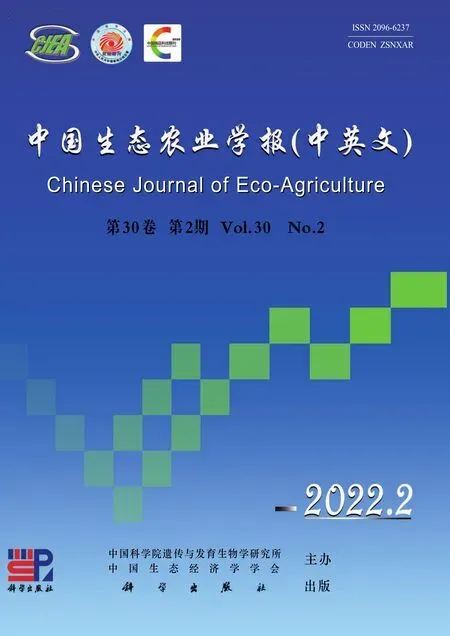Comparison of irrigation strategies for summer maize under deficit irrigation:Grain yield and water use efficiency*
ZHENG Mengjing,ZHANG Lihua,ZHAI Lichao,DONG Zhiqiang,JIA Xiuling
(Institute of Cereal and Oil Crops,Hebei Academy of Agricultural and Forestry Science / Hebei Province Key Laboratory of Crop Cultivation Physiology and Green Production / Scientific Observing and Experimental Station of Crop Cultivation in North China,Ministry of Agriculture,Shijiazhuang 050035,China)
Abstract:The shortage of water resources in the North China Plain (NCP) poses a challenge to traditional agricultural irrigation methods.Adjusting and optimizing the irrigation mode is an important strategy for saving water and improving water use efficiency(WUE) and crop yield under water-limited irrigation conditions.Given this background,different irrigation modes were set in an automatic rainproof shed (to eliminate the effects of natural rainfall) in the two growing seasons of 2018 and 2019 to analyze the grain yield and WUE of summer maize.In this experiment,a randomized block design was adopted,and two irrigation methods were applied:border irrigation (BI) and micro-sprinkler irrigation (SI).Based on the total irrigation amount and frequency,sample plots were divided into two groups for comparison.Plots in the first group (SI-225 and BI-225) had the same total irrigation amount (50% of evapotranspiration,ET) but different irrigation frequencies.SI-225 was irrigated six times,namely at the emergent seedling stage(VE),sixth leaf stage (V6),tenth leaf stage (V10),thirteenth leaf stage (V13),tasseling stage (VT),and milk stage (R3).BI-225 was irrigated three times at VE,V10,and VT.Plots in the second group (SI-225,SI-280,SI-352,and BI-450) had the same irrigation frequency but different total irrigation amounts (50%,60%,80%,and 100% of ET).Among them,SI-225 and BI-450 received a fixed amount of water per irrigation event,whereas SI-280 and SI-352 underwent supplementary irrigation according to their soil moisture content.The results showed that,compared with those of BI-225,the grain yield of SI-225 increased by 17.7%?20.2% and its WUE increased by 9.2%?12.7%.Further analysis of physiological characteristics revealed that SI-225 showed an improved upper soil water status (0?40 cm),increased photosynthetic rate (Pn),leaf area index (LAI),and dry matter accumulation,and consequently higher yield and WUE due to modest but highly frequent irrigation.Under the same irrigation frequency,the grain yields of SI-225 and SI-280 decreased by 21.2% and 12.0%,respectively,compared with that of BI-450.However,total water consumption during the growth period was reduced due to the decrease in LAI and transpiration rate (Tr) of SI-225 and SI-280,which resulted in an improved WUE.The grain yield of SI-352 did not differ significantly from that of BI-450,but its ET decreased by 9.8% due to the optimization of LAI and Tr,its irrigation amount decreased by 21.8%,and its WUE increased by 5.1%.Therefore,under water-limited irrigation conditions (50% of ET),the yield and WUE of summer maize could be increased by increasing the irrigation frequency,with modest but highly frequent irrigation promoting the best results.Moreover,under moderate water limitation (80% of ET),the application of micro-spraying supplementary irrigation based on soil moisture content allowed to achieve a stable yield and a high WUE.These results provide a theoretical reference for improving the efficiency of agricultural water use in water-deficient areas of the NCP.
Keywords:Deficit irrigation; Grain yield; Water use efficiency; Micro-sprinkler irrigation; Summer maize
Maize (L.) is a cereal crop widely planted in the North China Plain (NCP),accounting for 31.3% of the total maize production in China (National Bureau of Statistics of China,2019).However,maize production has been seriously affected by climate change in recent years,especially under dry conditions.Precipitation in this region varies greatly within spatial and temporal trends; this leads to water stress during the growth stages of maize,resulting in yield loss (Egli and Hatfield,2014;Gao et al.,2017).Therefore,supplementary irrigation is required to meet the water requirements of maize growth and development,and to improve grain yield (GY).Approximately 70% of groundwater is used in irrigation agriculture.Overexploitation of groundwater resources to increase crop production has led to severe water shortages in the NCP.Therefore,advanced irrigation regimes are essential for saving irrigation water and increasing water use efficiency (WUE).
Applying full irrigation to meet the water requirements of crops is becoming less popular due to the scarcity of water resources and to policy guidance for the reduction of irrigation water use.One valuable watersaving irrigation strategy,applied under water-limited conditions or in semiarid climates,is deficit irrigation(DI),under which less water is supplied than the crops require in order to increase the efficiency of the applied irrigation water while decreasing its amount (Fereres and Soriano,2007; Geerts and Raes,2009; Rop et al.,2016;Kang et al.,2017).Extensive studies have investigated the response of maize water productivity to DI.For instance,Stepanovic et al.(2021) have found that DI (50%of full irrigation water) caused a yield reduction of 2%?33% in maize,resulting in a 22%?47% improvement in WUE compared to that under full irrigation conditions.However,Zou et al.(2021) reported that a maize evapotranspiration of 80%,compared to that under full irrigation,during the interval between the eighth leaf stage and the physiological maturity stage (V8?R6)saved 44 mm of irrigation water and improved GY and irrigation WUE.
It is also important to determine the amount of irrigation water per application and the irrigation frequency allowing optimum water productivity under DI.Irrigation frequency influences the spatial distribution (Abdolahipour et al.,2018),root development (Jha et al.,2018),and water percolation (El-Hendawy et al.,2008) of maize,leading to varying levels of GY and water productivity,even for the same total irrigation amount.Indeed,Zhang et al.(2019) investigated the effects of irrigation intervals of 3,6,9,12,and 15 days under the same total irrigation amount (525 mm) on maize GY and WUE,and found that a 6-day interval between irrigation events contributed to optimizing the soil moisture conditions of the upper 60 cm of the soil layer,reduced evapotranspiration,and ultimately achieved the highest yield and WUE.Other studies have indicated that increasing the irrigation frequency while applying smaller irrigation quotas per application could accelerate crop development and improve GY,whereas reducing the irrigation frequency decreased GY (Bian et al.,2016; Chachar et al.,2020).Similarly,Muhumed et al.(2014) showed that both above-ground biomass and GY increased with frequent irrigation under DI conditions.Conversely,an overly low irrigation frequency with a larger irrigation amount per application may cause crop water stress at key water requirement stages and increase the risk of deep percolation.Furthermore,excessive or insufficient irrigation frequencies result in ineffective soil water evaporation (Zhang et al.,2019).Hence,appropriate irrigation frequencies should be identified to improve water productivity and reduce irrigation water.
An increased irrigation frequency with smaller water amounts per application is difficult to achieve through traditional procedures such as flooding irrigation or border irrigation.In fact,traditional methods do not allow the precise control of water volumes; conversely,when using smaller water volumes,they result in non-uniform irrigation and a lower WUE.Therefore,the installation of effective irrigation equipment is crucial for the appropriate exploitation of water resources and increased water productivity.Accordingly,advanced irrigation methods,such as sprinkler irrigation systems,have been applied to field crops; these enable the precise control of irrigation volume per application,thereby minimizing runoff and leakage while reducing labor requirements (Playán and Mateos,2006).Compared with flooding irrigation,sprinkler irrigation can save irrigation water by reducing unnecessary water loss and soil evaporation (Yu et al.,2009).Consequently,using sprinkler irrigation at a higher irrigation frequency with a smaller quota can optimize the soil moisture content by increasing total soil porosity,loosening the topsoil,and reducing soil cracking in the crop rhizosphere,which in turn accelerates crop development,decreases soil evaporation,and improves crop WUE (Sun et al.,2010; Xue and Ren,2016).Compared with flooding irrigation,sprinkler irrigation systems reduce some field microclimate parameters,such as atmospheric temperature and vapor pressure deficit (Liu and Kang,2007).Micro-sprinkler irrigation,a modified type of sprinkler irrigation using plastic tubes with equidistantlyspaced holes placed between two rows of crops,has gradually become popular in water-deficient areas.In summary,previous studies have mainly focused on the effects of different irrigation amounts on maize production; however,research on the mechanism by which micro-sprinkler irrigation promotes irrigation water conservation and WUE increase under DI conditions is scarce.Furthermore,there is little information on how to improve maize water productivity by applying smaller irrigation quotas at higher irrigation frequencies under rainout shelter conditions.
Therefore,the main objectives of this study were to 1) explore the effects of a smaller irrigation quota at different irrigation frequencies on maize water productivity;2) assess the performance of different total irrigation amounts with variable and fixed irrigation quotas per application on the GY and WUE of summer maize under DI; and 3) clarify the mechanism mediating various performance levels under different irrigation regimes.Our results provide technical guidance for the development of local maize production strategies characterized by water conservation and high efficiency.
1 Materials and methods
1.1 Experimental site description
The experiments were conducted during two growing seasons (2018 and 2019) at the Dishang Comprehensive Experimental Station,Hebei Academy of Agricultural and Forestry Sciences,which is located in the southeast of Shijiazhuang (37°56?N,114°43?E),Hebei Province,China.A moveable lysimeter/rain-out shelter facility was used,which can close automatically when rain falls to avoid the confounding effects of precipitation on soil water content.This consisted of 32 individual lysimeter plots (3 m × 2 m × 2 m of length × width ×depth) with a 3-m-high access chamber built underground that permitted measurement of the amount of percolating water.Each plot was bounded by a concrete barrier on all sides to prevent lateral water movement.A schematic of the lysimeter is shown in Fig.1.The soil type in the experimental site was loam,containing 15.7 g?kgorganic matter,1.0 g?kgtotal nitrogen,21.4 mg?kgavailable phosphorus,and 113.9 mg?kgavailable potassium in the upper soil (0?20 cm).Fig.2 shows the average daily temperatures that were recorded during the two maize growing seasons.
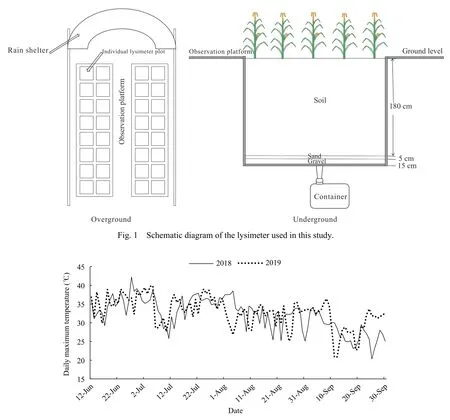
Fig.2 Daily maximum temperatures during the growing seasons of summer maize in 2018 and 2019 at the experimental site
1.2 Experimental material and design
The summer maize variety ‘Zhengdan 958’,which is widely planted in the NCP,was used as the experimental material.Seeds were sown on June 10,2018 and June 13,2019,and harvested on September 30in both years.Two irrigation methods,namely border irrigation(BI) and micro-sprinkler irrigation (SI),were used.BI is a traditional flooding irrigation method used by local farmers,and an effective irrigation method for water conservation.BI included two treatments (BI-450 and BI-225) during the two growing seasons.In treatment BI-450,irrigation was provided at the following stages:seedling emergence (VE),sixth leaf stage (V6),tenth leaf stage (V10),thirteenth leaf stage (V13),tasseling stage(VT),and milk stage (R3).In treatment BI-225,irrigation was provided at VE,V10,and VT.SI included three treatments (SI-225,SI-280,and SI-352),all of which were characterized by irrigation at the VE,V6,V10,V13,VT,and R3 stages.The total irrigation amount of BI-450,BI-225,SI-225,SI-280 and SI-352 was corresponded to 100%,50%,50%,60% and 80% of seasonal evapotranspiration (ET),respectively.The details of the irrigation protocols are described in Table 1.
BI-225 and SI-225 were characterized by the same total irrigation quota but different irrigation frequencies(three and six times,respectively),in order to clarify the effect of irrigation frequency on maize water productivity under DI (50% of ET).Similarly,SI-225,SI-280,SI-352,and BI-450 presented the same irrigation frequency but different total irrigation amounts to explore the effect of DI on maize GY and water use efficiency (WUE).SI-225 and BI-450 had fixed irrigation quotas of 38 mm and 75 mm per application,respectively,at six growing stages.However,SI-280 and SI-352 received various irrigation quotas according to their soil water content.SI-352 was deployed in 2019 to determine the effect of further optimization of the soil water content on maize GY and WUE.The detailed evaluation standards for SI-280 and SI-532 are listed in Table 2.In total,five integrated irrigation regimes (SI-225,SI-280,SI-352,BI-450,and BI-225) were arranged in a randomized complete block design with 4?7 replications.Before sowing,supplementary irrigation was carried out according to the specific soil water content,in order to make it reach 75% of the field capacity in the upper 0?100 cm of soil and thus ensure the consistency of soil water contents among plots.

Table 1 Irrigation methods,frequencies,amounts per application,and irrigation stages during the growing seasons of summer maize in 2018 and 2019

Table 2 Irrigation stages,monitored soil depth,and standards for determining the supplemental irrigation amount during the summer maize growing seasons of 2018 and 2019
1.3 Irrigation methods
In this experiment,BI was applied using a 12-cmwide plastic tube,which was used to simulate the flooding irrigation system used by local farmers.SI was conducted with a micro-spraying tube with a diameter of 5 cm with equally spaced holes every 2 cm.The irrigation amount was controlled by installing a flow meter at the outlet of the pipeline and set at a flow rate of 7.5 m?hand 30 m?hunder SI and BI,respectively.
1.4 Measurements
At the physiological maturity stage (R6),all ears(excluding border rows) in the plots were harvested manually to determine GY,number of ears per unit area,and 1000-kernel weight (KW) considering a 14% grain moisture content.Among these,15 representative ears were chosen to measure the number of kernels per ear.
For each plot,three representative plants within the middle of each plot were randomly selected and manually cut at ground level at V6,V8,V13,VT,R3,and R6.Plants were dehydrated to a constant weight in a drying oven at 75 °C and then weighed.
For each plot,three representative plants were selected.The leaf length (L) and maximum leaf width (W) of all green leaves were measured at V5,V8,V11,V13,VT,R2,R3,R4,R5,and R6.Leaf area was calculated as L×W×0.75 for spread-out leaves,and as L×W×0.5 for leaves that were not spread out.The total leaf area per plant was calculated as the sum of these two measurements.LAI was calculated as

1.4.4 Net photosynthetic rate () and transpiration rate ()
andwere measured 1 day before irrigation,7 days after irrigation,and 14 days after irrigation at V13.The middle parts of the ear leaves of five representative plants in each plot were selected forandmeasurement using a LI-6400XT portable photosynthesis system(LI-COR,Lincoln,NE,USA) at a photosynthetically active radiation (PAR) value of 1700 μmoL?m?s.The measurements were performed in the morning (10:00?12:00).
Soil volumetric water contents were measured every day in each 20-cm soil layer down to a 200-cm depth for all treatments using real-time monitoring EM50 devices(METER Group,Inc.,Pullman,WA,USA).The seasonal ET of summer maize was calculated based on the soil water balance equation (Kresovi? et al.,2016):

whereis precipitation (mm),is irrigation (mm),?SWD is soil water depletion at a depth of 200 cm (mm),is the surface runoff (mm),is the drainage below the 200-cm soil profile (mm),and CR is the capillary rise to the root zone (mm).In this study,was considered to be zero because the experiment was arranged in a waterproof shelter.Similarly,was considered to be negligible in our flat plots.Conversely,values were measured within the lysimeters.Since the experiment was conducted under DI conditions,deep percolation did not occur.CR was also considered negligible because our experimental plots were not linked to underground water.
The WUE was calculated in kg?musing the following equation:

whereis the GY (kg?hm) and ET is the total seasonal evapotranspiration (mm).
1.5 Statistical analysis
Analysis of variance (two-way ANOVA) and least significant difference (<0.05) tests were performed using SPSS ver.17.0 software (SPSS,Inc.,Chicago,IL,USA) to identify significant differences in GY,WUE,ET,LAI,,,and dry matter accumulation among plants subjected to the different treatments.All charts were plotted using SigmaPlot ver.10.0 software (Systat Software,Inc.,San Jose,CA,USA).
2 Results
2.1 Effects of irrigation strategies on the topsoil water status
Different irrigation treatments had obvious effects on the water content of the 40-cm topsoil (Fig.3).In particular,at the VE stage,the soil water content of the 0?40-cm soil layer of SI-225 was lower than that of BI-225 for the smaller irrigation quota (38 mm).However,the water content of the 0?40-cm topsoil of BI-225 was remarkably low at stages V6,V13,and R3 because of the lack of irrigation.The soil water content of SI-225 at 0–40 cm also increased at the V10 and VT stages,compared to that of BI-225 (Fig.3a).Overall,under the same irrigation frequency (six times)with different total irrigation amounts,the topsoil water content increased with increasing irrigation amounts at all growth stages (Fig.3b).

Fig.3 Soil water contents of the 0–40-cm soil layer under each treatment during the whole growing season of summer maize
2.2 Effects of irrigation strategies on the leaf area index (LAI)
Fig.4 shows the dynamics of LAI under different irrigation regimes during the various growth stages.LAI gradually increased along plant development,reaching a maximum at VT–R2,and then decreased to a minimum at R6.Different irrigation frequencies (SI-225,six times and BI-225,three times) had significant effects on LAI at the R3–R6 stages (<0.01,<0.05); however,there was no significant difference at the V5–R2 stages.Compared with the LAI of BI-225,that of SI-225 was increased by 19.3%,10.9%,7.5%,and 7.6% in 2018,and 5.9%,13.6%,19.3%,and 26.8% in 2019 at R3,R4,R5,and R6,respectively (Fig.4a,c).Different irrigation amounts (SI-225,SI-280,SI-352,and BI-450) also had significant effects on LAI (<0.05),which increased with increasing total irrigation amounts at the same stage.Compared with that of SI-225,the mean LAI at all growth stages of SI-280 and BI-450 increased by 14.8% and 23.3% in 2018 and that of SI-280,SI-352,and BI-450 increased by 4.5%,13.3%,and 30.5% in 2019,respectively (Fig.4b,d).The response tendencies of LAI to irrigation frequency and amount were consistent in the two growing seasons.
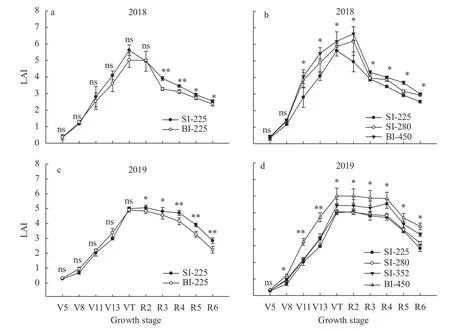
Fig.4 Effect of different irrigation amounts and frequencies on the leaf area index (LAI) of summer maize during the whole growing seasons of 2018 and 2019
2.3 Effects of irrigation strategies on dry weight(DW) accumulation
The DW provides a material basis for the formation of the GY.Fig.5 shows the responses of DW to various irrigation frequencies and total irrigation amounts.Different irrigation frequencies (SI-225,six times and BI-225,three times) had a significant effect on DW at VT–R6 (<0.05),but no significant difference was found at V6–V13 (Fig.5a,c).The DW of SI-225 increased by 38.1%,10.2%,and 11.3% in 2018,and by 10.0%,9.7%,and 9.6% in 2019 at VT,R3,and R6,respectively,compared with that of BI-225.Different irrigation amounts also had a remarkable impact on DW at VT–R6,but there was no difference among
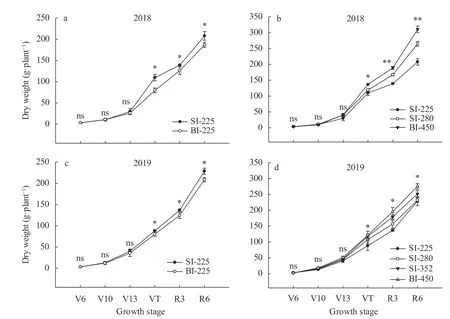
Fig.5 Effect of different irrigation amounts and frequencies on dry weight accumulation during the various growth stages of summer maize in 2018 and 2019
treatments at V6–V13 (Fig.5b,d).In the 2018 growing season,BI-450 and SI-280 showed a DW increased by 36.9% and 18.8%,respectively,compared with that of SI-225 (considering the mean DW at VT–R6).Similarly,in the 2019 growing season,BI-450,SI-352,and SI-280 exhibited a greater DW by 33.8%,24.9%,and 12.7%,respectively,compared with that of SI-225 (considering the mean DW at VT–R6).Overall,the annual response trends were similar in the two growing seasons.
2.4 Effects of irrigation strategies on the net photosynthetic rate (Pn) and transpiration rate (Tr)
Theandvalues recorded under different treatments are shown in Table 3.Theandof BI-225 was significantly higher than that of SI-225 prior to irrigation at V13 in 2018 (<0.05),butdid not differ significantly in 2019.However,compared with theof BI-225,that of SI-225 was remarkably increased by 8.2% and 11.2% in 2018 and by 13.2% and 17.4% in 2019 at 7 and 14 days after irrigation,respectively; similarly,were also remarkably increased by 22.2% and 18.9% in 2018,and by 44.9% and 38.5% in 2019 at 7 and 14 days after irrigation,respectively.At the three measured time points,andvalues decreased with lower irrigation amounts.Compared with theof BI-450,those of SI-225,SI-280,and SI-352 were reduced by 21.0%,13.5%,and 6.9%,respectively.Similarly,theof SI-225,SI-280,and SI-352 decreased by 32.8%,24.6%,and 15.4%,respectively,compared with that of BI-450 (considering the mean values relative to the three measured time points and the two growing seasons).These results indicated that increasing irrigation frequencies under DI may improve the photosynthesis-related characteristics of maize,thereby promoting the accumulation of biomass.Furthermore,decreasing irrigation amounts might reduce water consumption by transpiration.
2.5 Effects of irrigation strategies on grain yield and yield components
The values of GY and yield components under different treatments are presented in Table 4.SI-225 and BI-225 received the same total irrigation amount,but SI-225 was irrigated more frequently and exhibited significantly higher GY (<0.05).In fact,the GY of SI-225 was 17.7%?20.2% higher than that of BI-225 in the twogrowing seasons.SI-225,SI-280,and BI-450 were characterized by the same irrigation frequency but different irrigation amounts.Notably,GY increased with increasing irrigation amounts.Indeed,the GY of SI-225 and SI-280 decreased by 21.3% and 12.0% (considering the mean GY of the two growing seasons),respectively,compared to that of BI-450.The GY of SI-352,in which the soil water content was further optimized in 2019,was comparable to that of BI-450.Moreover,SI-225 and BI-225 exhibited significant differences in spike number(SN),kernel number per spike (KN),and KW in the two growing seasons.Indeed,compared with those of BI-225,the SN,KN,and KW of SI-225 increased by 4.1%–5.3%,4.7%–12.0%,and 4.7%–7.4%,respectively.Conversely,the total irrigation amount (SI-225,SI-280,SI-352,and BI-450) had no significant impact on the SN.Nevertheless,KN and KW increased with increasing irrigation amounts; however,these did not differ significantly between BI-450 and SI-352.The GY of SI-352 was slightly lower than that of BI-450,but such difference was not significant.Altogether,these results indicated that increasing irrigation frequencies under DI may increase SN,KN,and KW,and consequently GY.The latter could reach the GY level at full irrigation via further optimization of the soil water content.

Table 3 Net photosynthetic rates (Pn) and transpiration rates (Tr) of summer maize before and after irrigation at the thirteenth leaf stage (V13) under different treatments in 2018 and 2019

Table 4 Grain yield and yield components of summer maize under different treatments during the two growing seasons
2.6 Effects of irrigation strategies on seasonal evapotranspiration (ET) and water use efficiency (WUE)
The ET and WUE values relative to different irrigation treatments during the two growing seasons are shown in Fig.6.Different irrigation frequencies (SI-225,six times and BI-225,three times) had a significant effect on WUE under DI.In particular,the ET and WUE of SI-225 were higher than those of BI-225 in 2018 and 2019,although the difference in ET was not significant.However,compared with the WUE of BI-225,that of SI-225 significantly increased by 9.6% in 2018 and 9.1% in 2019 (<0.05).The irrigation amount also exerted some effects on ET and WUE.Indeed,compared with the ET of BI-450,those of SI-225 and SI-280 were remarkably decreased by 22.3% and 22.1% in 2018,and by 25.8%and 20.0% in 2019 (<0.05),respectively.SI-352 also exhibited a 9.8% reduction in ET relative to that of BI-450 (<0.05,Fig.6).However,the WUE of SI-225 and SI-280 increased by 1.6% and 13.0% in 2018,and that of SI-225,SI-280 and SI-352 increased by 7.5%,10.0%,and 5.0% in 2019,respectively,compared with that of BI-450 (Fig.6).
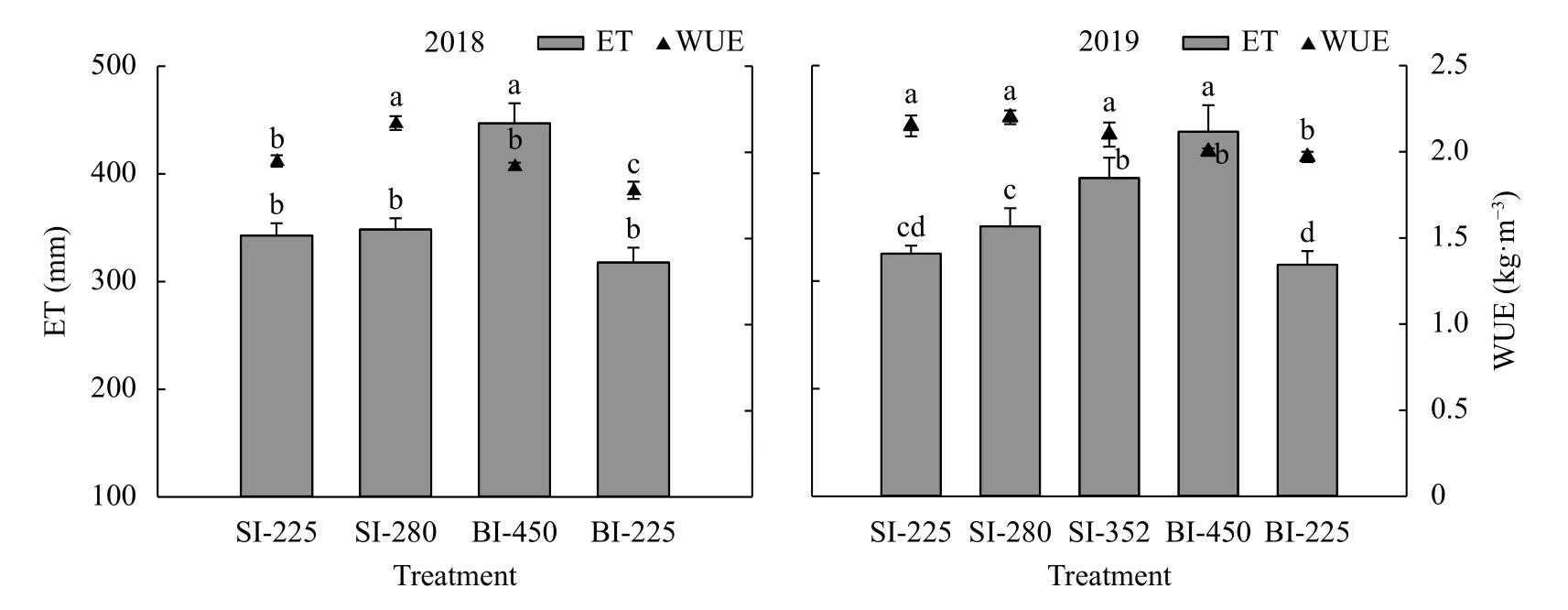
Fig.6 Evapotranspiration (ET) and water use efficiency (WUE) of summer maize under different irrigation treatments in 2018 and 2019
3 Discussion
In the NCP,precipitation is uneven during the summer maize growing period,and total annual precipitation volumes have varied greatly in recent decades due to the influence of global climate change.Therefore,supplemental irrigation was applied to meet the needs of normal maize development.However,groundwater resources have been overexploited for irrigation agriculture,which has led to serious water shortages.Advanced irrigation methods,such as sprinkler irrigation or microsprinkler irrigation,coupled with appropriate irrigation regimes,are effective strategies for saving irrigation water and improving GY and WUE of crops,particularly in water-deficient areas (Kang et al.,2010).Increasing irrigation frequencies with a smaller irrigation amount per application can meet the demands of developing crops(Chachar et al.,2020).Hence,micro-sprinkler irrigation has become more popular for precise water supply.In this study,micro-sprinkler irrigation was used for providing smaller irrigation quotas at a higher irrigation frequency,which could improve irrigation uniformity.
Many studies have reported that the use of moderate DI can improve maize yield and WUE in semi-arid or water-deficient environments (Kresovi? et al.,2016;Stepanovic et al.,2021; Zou et al.,2021).DI has been widely implemented worldwide to reduce the exploitation of groundwater (Jensen et al.,2014).This study analyzed the impact of various extents of DI and irrigation frequencies on maize yield and WUE in the NCP.In this study,the GY of summer maize was significantly improved by increasing irrigation frequencies with reduced quotas per application using micro-sprinkler irrigation under DI.In particular,the SI-225 treatment,in which the irrigation frequency was increased from three to six,increased the GY significantly by 18.9%.This result indicated that the potential maize productivity can be further improved by providing smaller irrigation amounts at higher frequencies under water stress conditions.In this study,although GY was improved by increasing irrigation frequency while providing smaller irrigation quotas under DI (total irrigation amount,225 mm),the final GY was remarkably lower than that under full irrigation(450 mm).Hence,supplementary irrigation based on soil water content before irrigation was further assessed as a method to attain a stable GY.A previous study showed that adequate supplementary irrigation to reach an optimal soil water content could increase GY in the Huang-Huai-Hai Plain in China (Guo et al.,2015).In the present study,SI-225,SI-280,SI-352,and BI-450 were characterized by the same irrigation frequency but different
total irrigation amounts.For consistency with the irrigation method used by local farmers,a water amount of 450 mm was provided by border irrigation.Under the higher irrigation frequency (six times),SI-225 (50% of ET) exhibited a 21.3% lower GY than that of BI-450(100% of ET).However,SI-280 (60% of ET) exhibited an improved GY due to the increased total irrigation amount,which narrowed the gap with that of BI-450 to 12.0%.Moreover,the GY of SI-352 (80% of ET) was further improved,becoming comparable to that of BI-450.These results showed that a decreasing degree of water stress had a positive impact on GY and water conservation.These findings were in accordance with those of Sampathkumar et al.(2012),who reported that DI at 75%?80% of full irrigation could stabilize GY.However,Zou et al.(2021) reported that regulated irrigation (80%of crop ET) resulted in an overall higher yield than control group (100% of crop ET).The differences between the results of these studies may depend on different climate conditions,soil profiles,and maize varieties.
To explain the reasons for the observed differences in GY among treatments,this study further analyzed yield components,biomass accumulation,and soil water conditions.Yield components include SN,KN,and KW.The DW is the material basis for the formation of GY,and the post-anthesis DW is of primary importance for grain weight formation (Li et al.,2019).Previous research has indicated that ensuring a suitable post-anthesis soil water content is an effective measure to improve biomass productivity (Gheysari et al.,2017; Lin and Wang,2017).In addition,Jha et al.(2018) reported that “l(fā)ow-amount and high-frequency” irrigation mode contributes to providing a suitable soil water content at the grain filling stages,and thus improving GY.In the present study,increasing irrigation frequencies with amounts lower than 50% of those under full irrigation conditions (total irrigation amount,225 mm) contributed to improving the topsoil water conditions,as shown by the reduced fluctuation in topsoil moisture content under SI-225 compared with that of BI-225,and subsequently to increasing DW accumulation,especially in post-anthesis stages; the latter may be the major factor explaining the observed increase in yield components and GY.The DW was determined according to the leafand LAI (Qi et al.,2020).Water stress or dry soil conditions during grain filling may accelerate leaf senescence; conversely,ensuring appropriate soil water contents contributes to delaying leaf senescence and improving GY (Ye et al.,2020).In this study,theand LAI were obviously improved by increasing irrigation frequencies under DI (50% of ET,total irrigation of 225 mm),which contributed to enhanced DW accumulation.Under the higher irrigation frequency,the SN of plants under various treatments was not significantly affected by the application of supplementary irrigation,compared with that of the BI-450 treatment.However,the KN and KW of SI-225 were overall lower than those of BI-450 due to the lower LAI and DW,which mainly depended on the reduced soil water content.The KN and KW of SI-280 were further improved by optimizing the soil water conditions of the 0–40-cm topsoil layer.The KN and KW of SI-352 were slightly lower than those of BI-450,but such difference was not significant.Overall,optimized soil water conditions were key to improving GY components,including an increase in LAI post-anthesis,,and DW,which contributed to maize development.These findings are consistent with those of Kresovi? et al.(2016),who showed that GY increased more gradually with increases in irrigation volume than under rain-fed treatments.
Improving maize WUE is also important for coping with water shortages under DI.WUE is determined by the GY and the total seasonal ET.Previous research has shown that,under various irrigation regimes,irrigation frequency affects crop water productivity when irrigation is limited (Fang et al.,2018; Chachar et al.,2020).In the present study,the ET of SI-225 was greater than that of BI-225; nevertheless,since the former also showed increased GY,SI-225 showed an increase in WUE.Hussain et al.(2019) also indicated that increases in WUE mainly depend on increases in GY under drought conditions.The higher LAI and transpiration rate () can also explain the increased ET of SI-225.These results indicate that WUE can be improved by increasing irrigation frequency with a smaller irrigation quota per application,amounting to less than 50% of that under a full irrigation regime (225 mm).Indeed,under the higher irrigation frequency (six times),SI-225,SI-280,and SI-352 exhibited significantly higher WUE than that of BI-450 in 2019.However,the WUE of SI-225 and SI-280 did not differ significantly from that of BI-450 in 2018,which mainly depended on the relatively higher ET and lower GY.The maximum daily temperature was higher during the VT stage of 2018 (Fig.2),which hampers GY.A previous study also reported that higher temperatures lead to increasing crop ET,while extremely high temperatures also affect pollination and grain filling,resulting in GY loss(Wang et al.,2021).Overall,our results indicated that supplemental irrigation based on soil water conditions(SI-352) could stabilize GY and increase WUE under DI.It should be noted that the experiment described in this study was carried out in a rainproof shed,which excludes the influence of natural rainfall.Therefore,the optimal amount of supplementary irrigation of summer maize in the field should be determined by monitoring soil moisture during key growth periods.
4 Conclusion
In the NCP,GY and WUE were improved by microsprinkler irrigation with small quotas at higher frequency under DI conditions (50% of ET); this effect could be attributed to an optimized development during the filling stages.Furthermore,soil water conditions during the key growth period could be optimized by supplemental irrigation to regulate crop growth,reduce water consumption,achieve stable GY,and ultimately improve WUE.The results of this study have important theoretical significance in guiding yield stabilization and improving the WUE of summer maize in water-limited regions.

